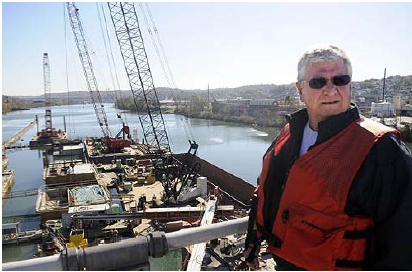
Pittsburgh Post-Gazette
3 November 2008
By Don Hopey,

Lockmaster John Booker looks over Locks and Dam 4 in Charleroi, where a major new construction project is under way for the river wall.- Andy Starnes/Post-Gazette
On the Monongahela River at Charleroi, construction is progressing at Lock and Dam No. 3 on a new river wall, the first step in a planned replacement and upgrade of the dam's two locks.
But that progress will grind to a halt when the steel rebar and concrete wall is finished. The critically needed lock replacements, part of the Army Corps of Engineers' Lower Mon Project to fix old, deteriorating and unsafe Mon River navigational dams at Charleroi, Braddock and Elizabeth, won't be funded for at least three years or finished for even longer.
That's because the federal Inland Waterways Trust Fund, which by law must provide half of the dollars for the maintenance and repair work, is nearly bankrupt.
The trust fund, which annually collects about $90 million through a 20-cent-a-gallon tax on diesel fuel used by barge industry tow boats, has been spent down and depleted by lock and dam projects further down the Ohio River in Kentucky.
"There are huge and expensive repair projects going on now at Olmstead Locks and Dam on the lower Ohio River, an ultra-expensive repair project that could cost up to $2 billion," said James McCarville, Port of Pittsburgh Commission executive director. "That's not an intelligent way to do maintenance -- to wait until the locks and dams break down."
As a result, Mr. McCarville said, the Lower Mon Project, also called the "Two for Three" because in addition to upgrading the locks at Charleroi and building a new dam at Braddock it will remove the 101-year-old dam at Elizabeth, is woefully behind schedule. It was supposed to be done in 2004, but the only part completed was the new dam at Braddock.
Because of the insolvency of the trust fund, the corps can't draw on federal money to remove the 101-year-old Elizabeth Locks and Dam, which the corps has rated "unsafe and critically near failure."
"When we complete that river wall and the contract expires, unless there is money in the trust fund, construction will cease at Charleroi," said Col. Michael Crall, commander and district engineer for the corps' Pittsburgh District.
He said that despite a significant backlog of repairs and replacement projects on Pittsburgh area river navigation dams, the corps has not let any new contracts in fiscal 2008 and doesn't expect to in fiscal 2009.
The corps now says the Lower Mon Project, originally priced at $800 million, won't be finished until 2016 or 2022, and could cost a total of $1.2 billion to $1.5 billion. To bridge that gap, the corps is spending $5 million in emergency federal funds on the Elizabeth Locks and Dam and $1.5 million a year to, according to Col. Crall, "provide urgent action required to temporarily fix and elongate the life span of the dam until we can remove it."
According to the corps, most of the 23 Pittsburgh area locks and dams are "highly unreliable" and "critically near failure," and more than half are at high risk for breakdowns that would halt commercial transportation in the nation's biggest inland port.
And just last week, the corps said it had discovered severe erosion under the 80-year-old Allegheny Lock and Dam No. 6 near Freeport, Armstrong County, that undermined its stability and necessitated emergency repairs that will cost millions of dollars. Emergency repairs are not subject to the required trust fund match and will be started before the end of this year.
But lengthy delays caused by the depletion of the trust fund are affecting already overdue work on the Dashields, Montgomery and Emsworth locks and dams on the upper Ohio River in Pennsylvania that are among the oldest dams and smallest locks in the corps' river navigation system. The system stretches down the Ohio and Mississippi rivers to New Orleans.
"Because of the stress on the trust fund we have to prioritize and the dam at the most risk is the one at Emsworth," Col. Crall said. "If we lost Emsworth, river traffic would come to a standstill. We wouldn't have the pool at the Point and you'd be able to walk across."
The corps and Congress agreed to fund $165 million of emergency repairs to correct erosion under the Emsworth Dam without a trust fund match, but that won't include needed work on the locks.
"The locks there need to be replaced and enlarged. That's where the bottleneck for river traffic starts," Mr. McCarville said. "And the Emsworth problems will repeat at Montgomery if we don't do proper maintenance. We in southwestern Pensylvania need to do something to protect the locks and dams. If we don't it could have disastrous consequences."
If any of the locks on the upper Ohio River or lower Monongahela River were to fail, they would isolate commercial river activity around Pittsburgh and damage operations of two steel companies, the nation's largest coke production plant at Clairton and five coal-fired power plants.
Mr. McCarville said a number of proposals have been made to break the funding logjam. The Bush administration has proposed new lockage user fees on commercial towing, a proposal the industry opposes.
"Now that the trust fund has gone broke, the corps can't do anything until it is replenished. And local industry says it's paid its share and is reluctant to agree to an increase in the tax," Mr. McCarville said.
"We need a long-term fix for the trust fund match formula but we also need a short term fix and that's why we're talking about the stimulus package. These projects are running way behind schedule and despite the waterways operators' payments to the fund, they're not receiving the benefits."
Don Hopey can be reached at dhopey@post-gazette.com or 412-263-1983.
First published on November 3, 2008 at 12:00 am